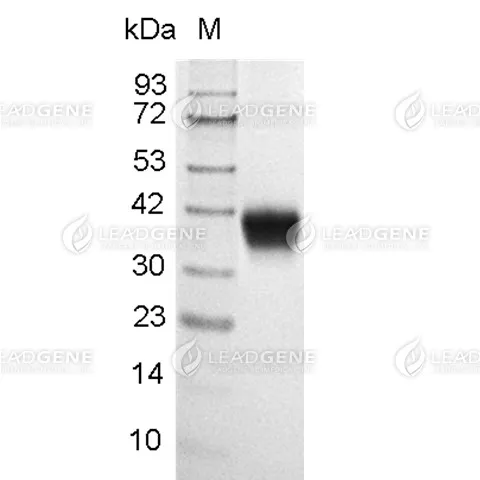-
Species of Origin
Mouse
Expression System
CHO
-
Affinity Tag
His Tag (C-term)
Storage Buffer
Lyophilized from a 0.2 µm filtered solution of PBS, pH 7.4.
-
Purity
>95% as determined by SDS-PAGE analysis.
Molecular weight
The protein has a calculated MW of 30.61 kDa.
The protein migrates as 36-42 kDa under reducing condition (SDS-PAGE analysis). -
Endotoxin Level
<0.1 EU per 1 μg of the protein by the LAL method.
Mycoplasma
Not detected
-
Form
Lyophilized

-
Specifications
-
Background
-
Background
CD38, a transmembrane glycoprotein, is widely expressed on immune cells such as B cells, T cells, and natural killer cells, as well as non-immune cells like endothelial cells. It functions as a multifunctional enzyme with ADP-ribosyl cyclase activity, catalyzing the conversion of NAD+ to cyclic ADP-ribose and nicotinic acid adenine dinucleotide phosphate. CD38 regulates calcium signaling, cell adhesion, and differentiation, playing essential roles in immune responses and inflammation. Moreover, CD38 is also a therapeutic target in multiple myeloma, where its expression correlates with disease progression. Understanding CD38's diverse functions is crucial for developing targeted therapies in immunology and oncology.
Synonyms
2'-phospho-ADP-ribosyl cyclase, 2'-phospho-ADP-ribosyl cyclase/2'-phospho-cyclic-ADP-ribose transferase, 2'-phospho-cyclic-ADP-ribose transferase, ADP-ribosyl cyclase 1 (ADPRC 1), Cyclic ADP-ribose hydrolase 1 (cADPR hydrolase 1), I-19, NIM-R5 antigen
-
Uniprot ID
P56528
Sequence Note
Leu45-Thr304
-
-
Instruction
-
Reconstitution
It is recommended to reconstitute the lyophilized protein in sterile H₂O to a concentration of 200 μg/mL and incubate the stock solution for at least 20 min to ensure sufficient re-dissolved.
Shipping
The product is shipped with polar packs. Upon receipt, store it immediately at -20°C or lower for long term storage.
-
Stability & Storage
This product is stable after storage at:
- -20°C for 12 months in lyophilized state from date of receipt.
- -20°C or -80°C for 1 month under sterile conditions after reconstitution.
Avoid repeated freeze/thaw cycles.
-
-
Image
1/1 -
Review

Help others learn more about this product. Use the link below to share your experience.
-
Publication

There are currently no publications. Use the link below to let us know.
-
Datasheet & Documents
1/1
Disclaimer:For Research Use or Further Manufacturing Only.
